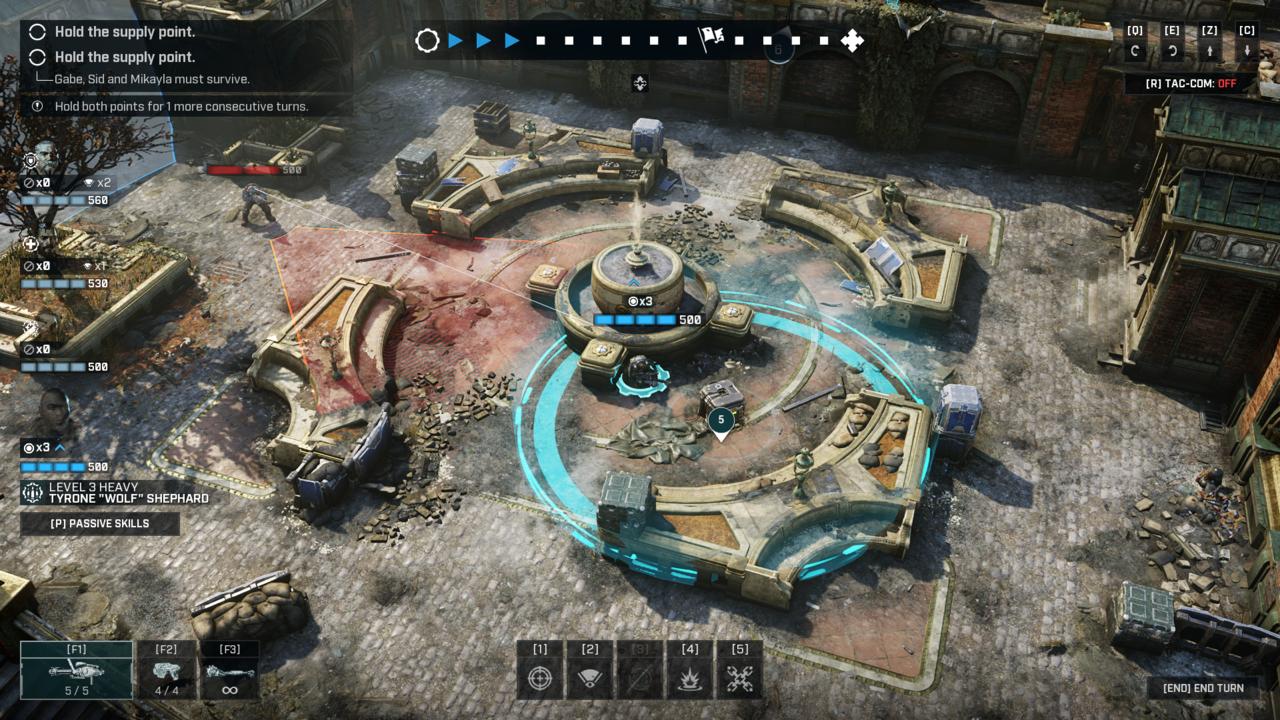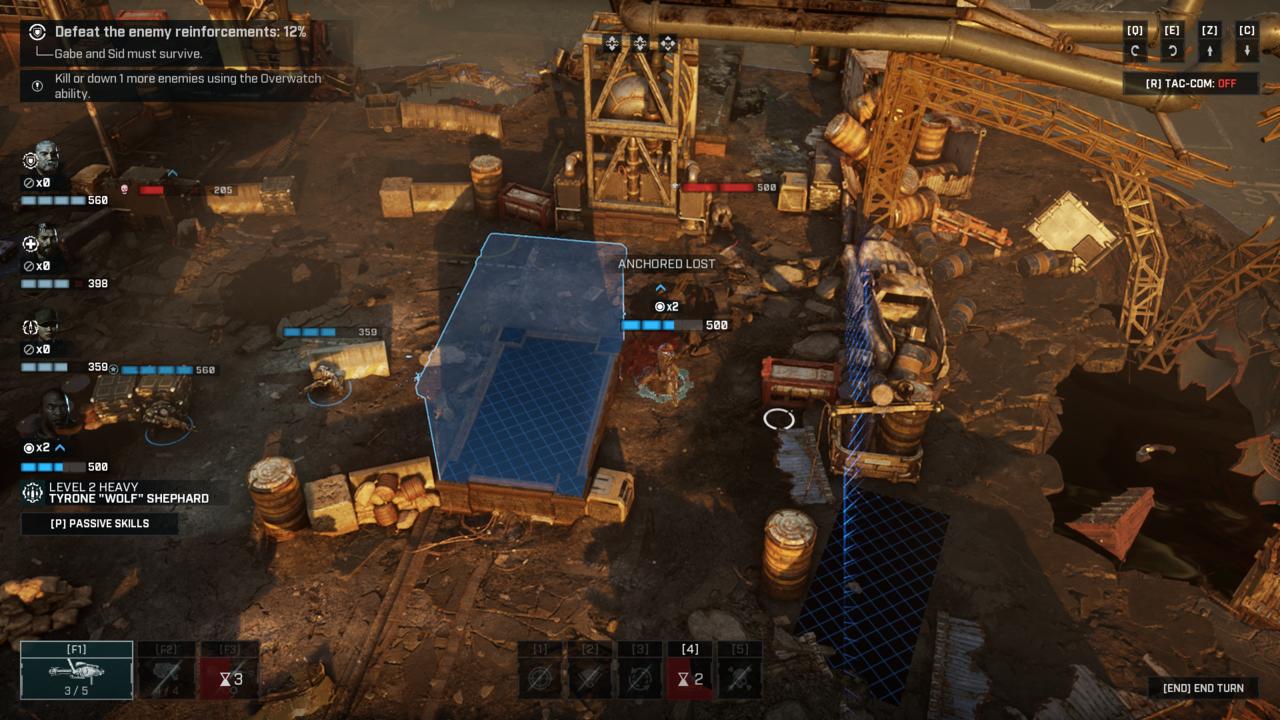Editor's note: Below are our impressions of how the Gears Tactics runs on Xbox Series X, also by Gears Tactics reviewer Mike Epstein. You can also read our full Series X review for an in-depth breakdown of the next-gen console. Continue after the break for the original Gears Tactics review.
With the launch of the Xbox Series X and S, Microsoft has released the Xbox One and Xbox Series X/S versions of Gears Tactics. Strategy games like Gears Tactics do not automatically translate well to consoles, where good gamepad controls are a must, but Gears Tactics lands the jump to consoles gracefully. Though using an analog stick to move a cursor will always be slower than using a mouse, the pensive turn-based gameplay does not lose anything in translation.
Like many cross-gen games so far, Gears Tactics gets scaling technical benefits, depending on the console on which you play it. On the Xbox One X, you can choose to play in 4K at 30fps or at 1440p running 60fps. On the Xbox Series X, the game runs in 4K resolution and at 60fps. As a tactics game employing a pulled-back, RTS-style camera, the increased fidelity doesn't make as big of an impact as it does in other games where you can look closely at every detail. Still, when given the opportunity, you can see that the world, particularly the characters, look very sharp.
With the console release of the game, there's a new update for all platforms, including PC. It adds an updated version of the campaign, which includes a new character, enemies, and more loot. In the updated campaign, Jack, the cloaking, door-ripping robot from the core Gears of War series, joins your team. Once found, Jack serves as a mandatory fifth squad member on every mission, based on the first three hours of the new campaign. It can't attack, but Jack offers a wide, customizable array of offensive and defensive support skills to make your team more effective and efficient. To balance out the impact of your team having an extra member on your side, many of the missions have been redesigned, adding extra enemies. There are also special Deviant-class enemies who power up their nearby allies, similar to how Jack bolsters your team.
Jack and the deviant enemies theoretically add a new layer of challenge. Using Jack effectively requires careful coordination; on a good turn, it can clear the path for you to kill more enemies and build even more momentum. Likewise, the Deviant enemies can force you to shift priorities in combat, as they're not only powerful but also make all of your enemies more deadly. At the same time, all of the extra stuff--more moves to make, more enemies to fight--makes each level drag on longer than it needs to. At the start of a new game, you can choose between playing the Jacked campaign with these new features or a Classic campaign. Though I'm still working through the new campaign, I'd argue that the original is a tighter, more satisfying experience. That said, if you've finished the Gears Tactics story and want a new thrill, replaying the campaign with Jack and Deviant enemies is far more interesting than simply running randomly generated veteran missions. – Mike Epstein, 5 November 2020. The original review, first published in April 2020, continues below.
Gears of War, as a series, has always required tactical planning. Understanding how to read a battlefield to find ideal cover and a path to outflanking your opponent is just as essential as your trusty Lancer assault rifle. Still, it's surprising just how well the series translates to a turn-based strategy RPG. Gears Tactics captures the chaotic, gory roller coaster energy generated by the shooters, even as your focus turns from playing a cog to maintaining the machine.
Technically, Tactics is a prequel, as it takes place before the events of the original series, but it really feels like a throwaway story from the expanded canon. Though connections to the overarching Gears saga, particularly Gears 5, abound--your unit is led by Gabe Diaz, Kait's dad--Gears Tactics' story is simple and mostly detached from the larger franchise.
So while the plot takes a back seat, Gears Tactics cleverly twists the formula of the modern strategy RPG, creating scenarios that fit the Gears mold. All the XCOM-inspired mechanics are there: action points that can be used to move or attack, half- and full-cover, defensive "overwatch" positioning. If you've ever so much as thought the word "tactics game," the flow will feel comfortable.

It will also feel incredibly familiar to Gears fans. Nearly every single mechanic and system from the core series appears in a turn-based form, and most of them fit remarkably well. Downing enemies (then executing them) becomes vital, as it awards your squaddies extra actions. Rushing in with the Lancer chainsaw is an aggressive way to clear a path through an enemy, but only if you can reach them without taking overwatch fire. Not only do the mechanics and stylistic flourishes of the Gears series make sense in a turn-based environment, but you can build strategies around them.
Likewise, almost every enemy type is imported from the shooter series, with stats and traits that transpose their real-time action identities into a more stats-driven turn-based form. Wretches still get in your face, creating dangerous distractions. Some of the more advanced enemies, like Boomers, will drop their powerful explosive weapons, creating an opportunity for you to turn the enemy's heavy firepower back on them.
However, in a few cases, the Gears-like systems clash with the tried-and-true XCOM-like ideas, making them feel unnecessary. For example, you're able to build up a squad of over 20 Gears through the story missions, but since many missions require that you use the small set of core story characters--Gabe Diaz and his crew--you rarely use more than a few alternates, and only when your go-to characters are restricted.
When the two identities merge, you get scenarios that mimic the flow and intensity of the combat arenas in Gears shooters, even as they play out in a more controlled, formulaic way. On paper, your standard squad of four Gears are always outnumbered and outgunned. Each wave of enemies carries a certain momentum, which evokes a moment of doubt as to whether or not you even have a chance to survive. Scouring derelict cities and abandoned factories of varying shapes and sizes, you'll move from cover to cover, trying to put your team in the best possible position to take on whatever's just around the corner. In true Gears fashion, even if you can handle what you find off the bat, there's always another wave of reinforcements or a new emergence hole popping up, spawning enemies behind your back.
Though the situation never adds up in your favor, there's almost always a solution to the threat you're facing. Whether you choose to dig in and brace from a defensive position or clear through the Locust horde, you have to employ your strategic acumen reactively, combining your squad's moves and attacks in the most efficient, sustainable way possible. Each character can "act"--move, shoot, or use a class-specific ability--three times per turn. On top of that, specialized perks and gear often give you plenty of opportunities to earn extra health or moves. Even when you feel like you've been backed into a corner, there's always a move that will give you a small chance of doing something to turn the tide, crack the mission wide-open, and shift the momentum back your way. When it works, and that one cautious shot turns into a 20-move assault, it feels like you cobbled together one of those reactionary hail-mary schemes Marcus Fenix seems to pull off in every Gears set-piece.
When it works, and that one cautious shot turns into a 20-move assault, it feels like you cobbled together one of those reactionary hail-mary schemes Marcus Fenix seems to pull off in every Gears set-piece.
The beauty of Gears Tactics is that those maneuvers are entirely contingent on how you develop your characters. Each Gear falls into one of five classes corresponding to a specific weapon: Support fighters get the Lancer, the more aggressive Vanguard gets the Retro Lancer, Scouts get a Gnasher shotgun, and so on. As each one gains experiences and levels up, you're able to augment them with skills and passive perks from a large four-sided skill tree. Each corner of the tree, which is actually square and not very tree-like, gives you different abilities and grants bonuses to a character's unique skill-set that encourage you to use them in specific ways. The Support is the healer, and you can enhance those abilities, but you can also build around finding ways to give the other three characters extra moves every turn. Customizing each character, both through leveling them up and furnishing them with weapon mods and armor, not only makes them more powerful, but more specifically useful. Creating a team that complements each other and how you approach situations tactically not only feels like "progress," but growth. As you come into your own as a commander, your Gears find their footing as soldiers.
And even within those sub-classes, there are interesting thematic variations. I specced out Gabe Diaz, a support unit, as a healer, but I also made sure to grab all the abilities that enhanced his Chainsaw attack. By the end of the game, using the chainsaw gave every character an extra move, sped up the cooldowns on all of his abilities, and healed the entire party.

At the same time, though, that specificity intensifies how repetitive the game starts to feel. Though the campaign took over 35 hours to complete, there are only a handful of mission types, including a King of the Hill-style point control, a turn-limited character rescue, and myriad excuses to kill every Locust in sight. While many are engaging, challenging, and exciting the first couple times, they start to wear thin as you repeat them over and over again. Over time, the game will throw in modifiers and optional objectives to spice things up, and those variations plus little tweaks to enemy groupings are enough to make each mission feel fresh in the moment. However, there's no replacement for actual objective and level variety over the long haul.
The only truly novel missions are a trio of boss battles where you square off against some of the series' biggest, baddest enemies. These fights are demanding, long-winded endurance runs. In addition to the boss monsters, who have large sweeping attacks that force you out of cover, you'll have to fight waves of standard enemies, who aren't exactly easy to handle. At a glance, you could argue that these fights are the epitome of the Gears Tactics format: Every turn requires you to react to new, potentially game-ending circumstances while also moving towards your objective and planning for what your opponents will do next. Really, they're too much of a "good" thing. The big attacks feel more restrictive than awe-inspiring, and the drawn-out spectacle minimizes the momentum that pushes you through the standard missions.
Though Gears Tactics wears itself a little thin by the end of its protracted campaign, the rush of pulling together a victory from the jaws of defeat carries an exciting, chaotic energy. Unlike most strategy games, playing well doesn't necessarily make you feel like a mastermind, so much as though you've cheated death. Every successful plan, even a last-ditch effort, feels like a small stroke of genius. That's no small feat.



















